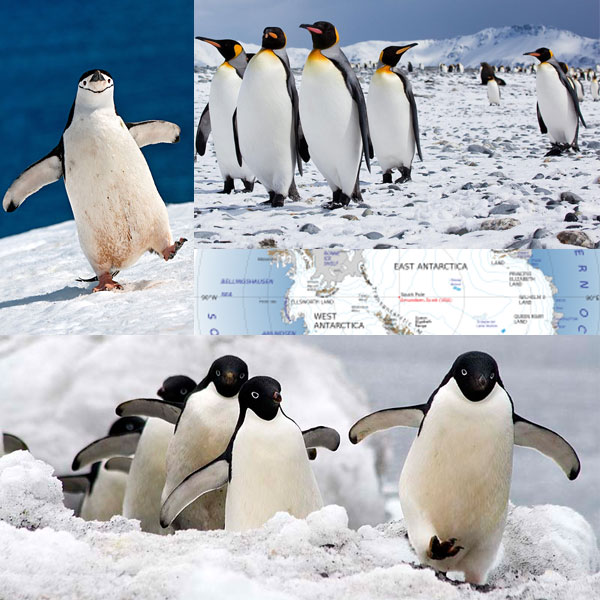Antarctica
- If Antarctica's ice sheets melted, the worlds oceans would rise by 60 to 65 meters (200 - 210ft) - everywhere.
- Antarctica is the southernmost continent on Earth.

- Penguins are the group of Antarctic birds that everyone thinks of first, but there are actually more petrels than there are penguins! Petrels include albatrosses, fulmars, prions, shearwaters, storm petrels, diving petrels and Gadfly petrels. Petrels are found in all the world's oceans, but there are more in Antarctic waters than anywhere else.

There are 17 species of penguins in the world, all found in the southern hemisphere.
- Gentoo - The largest of this group and stands about 80cm (32in) tall.Adélie
- Chinstrap emperor - excitingly the largest penguin, standing at nearly 120cm (about 4ft), and is usually encountered singly or in small groups on sea ice.
- Macaroni penguins
- Rockhopper
- King
- Magellanic
- Adélie penguins - are entirely black and white.
- Brush-tailed penguins etc
- Samples of ice known as ice cores are regularly drilled through the ice in Antarctica by scientists.
- The Antarctic continent wasn't even actually seen until 1820. No man set foot in Antarctica until 1895. The first human landing there is claimed by Henryk Bull, with a party from a whaling ship. They landed at Cape Adare . It was 1935 before the first woman set foot there. Her name was Catherine Mikkelson, and she was the wife of a Norwegian whaling captain. The South Pole was first reached by a Norwegian named Roald Amundsen in 1911, and shortly after by British explorer Robert Scott.
- Snow falling at the South Pole takes about 100 000 years to, flow to the coast os antarctica before it drops off the end as part of an iceberg.
- Other birds that live in or breed in Antarctica include cormorants, gulls, skuas and terns and land birds including sheathbills and pintail ducks.
- Antarctica is bigger than Europe and almost double the size of Australia.
- Most of Antarctica is covered in ice over 1.6 kilometres thick (1 mile.
- It is the only continent without reptiles.
- Plants grow in Antarctica in ice-free regions (only about 2 percent of the continent is ice-free). Lichens and moss grow in any favorable niche, including in sand, soil, rock and on the weathered bones and feathers of dead animals. Algae also grows in Antarctica.
- Antarctica is pushed into the earth by the weight of its ice sheets If they melted, it would "spring back" about 500m (1 625 ft). It would do this v...e...r...y s...l...o...w...l...y taking about 10,000 years to do so.
- Around 90% of the ice on Earth is found in Antarctica.
- The coldest place on earth is a high ridge in antarctica where temperatures can dip below -133°F (-93.2°C).
- It is the largest desert in the world.
- Some parts of Antarctica have had no rain or snow for the last 2 million years.
- There is a waterfall in Antarctica that runs red.
- 90% of the world’s fresh water is in Antarctica.
- You cannot work in Antarctica unless you have had your wisdom teeth and appendix removed.
- It is the only continent without a time zone.
- Antarctica is the coldest, windiest, highest, and driest continent on Earth.
- The first confirmed sighting of the continent was in 1820.
- The ice can be more than 4 km thick in some places. This ice flows
off the continent and creates floating ice shelves over the ocean; these shelves break up and create icebergs. If Antarctica’s ice sheets melted, the world’s oceans would rise by 60-65 meters.
- Explorers first reached the South Pole in 1911.
- There are 300 lakes beneath Antarctica that are kept from freezing by the warmth of Earth’s core.
- Antarctica is the best place in the world to find meteorites. Dark meteorites show up against the white expanse of ice and snow and don't get covered by vegetation. In some places, the way the ice flows concentrates meteorites there. The ice makes them gather in one place.
- There are at least seven Christian churches in Antarctica.
- There are no countries in Antarctica; the continent is governed by an international treaty (the Antarctic Treaty).
- Eskimos and polar bears are found in the ARCTIC, not the Antarctic.
- Antarctica is the only continent with no native species of ants.
- All warm-blooded animals living on and around Antarctica--whales, seals, sea birds, penguins--rely on thick layers of blubber to insulate them from the cold. The layer of blubber on a Weddell seal can be up to 4 inches thick.
- Because Antarctica lies in the southern hemisphere, seasons there are the opposite of seasons in the north — summer runs from October to February and winter covers the remainder of the year.
- There are no permanent residents. But up to 1,000 people may be wintering over at various research stations.
- Fifty million years ago Antarctica had a temperate climate, evergreen forests and many more kinds of animals than it has today. As the icecap slowly formed, most of the animals that lived there in ancient times were obliterated. Evidence of this once warm climate is in the fossils of plants, including fossil ferns, found by scientists.

